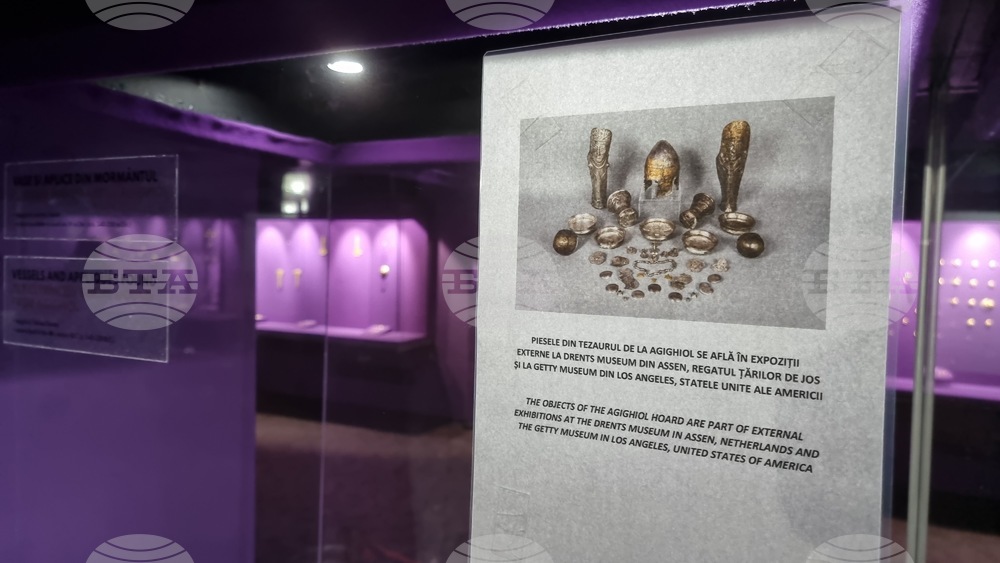site.btaUPDATED Romania’s National History Museum to Present 14 Artefacts in Getty Museum Thracian Exhibition


The National History Museum of Romania is participating with 14 artefacts in the upcoming exhibition Ancient Thrace and the Classical World: Treasures from Bulgaria, Romania, and Greece at the Getty Museum in Los Angeles, United States. The selected items are from the Agighiol treasure, Romanian National History Museum Director General, Ernest Oberlander, told BTA.
The objects with which Bulgaria's northern neighbour will take part in the exhibition include a silver parade helmet, greaves with silver gilding, silver vessels with images of mythical animals, parts of a harness with stylised images of horses and wolves.
"We received the invitation to participate from the Getty Museum a few years ago and we gladly accepted because the topic is very interesting - the world of the Thracians and the connections with the classical Hellenic world. The American colleagues are outstanding professionals," says Ernest Oberlander. He and his colleagues from Bulgaria and Greece have discussed together what artefacts to send to make the exhibition truly representative.
The artefacts
A gilded silver helmet, decorated with military and hunting scenes, and also with eyes on the forehead, is among the objects Romania will be exhibiting. "It is assumed that these eyes protected the wearer of the helmet from bad looks and frightened the enemy in battle," Oberlander told BTA
Other exhibits at the Getty Museum include gilded silver greaves (cnemids) decorated with the image of the Gorgon Medusa, a creature from Greek mythology that also warded off evil spirits.
"Interestingly, she has a tattoo on her face. The Thracian craftsman has depicted her in such a way that she looks like a noble creature from Thracian society that is being tattooed," the Director of the Romania's National History Museum said.
He and his team have also sent silver vessels to the United States with images of mythological fantastic animals, including snakes with the heads of predatory birds. "They are all part of the world of fairy tales, of the legends of the Getae, of the northern Thracians, in the 5th-4th centuries BC," Oberlander specified.
Visitors will also be able to see parts of a harness with stylized images of horses and wolves, as well as silver vessels.
The invitation
"We received the invitation to participate from the Getty Museum a few years ago and we gladly accepted because the topic is very interesting - the world of the Thracians and the connections with the classical Greek world. The cooperation was very good. The American colleagues are outstanding professionals," says Ernest Oberlander said.
This is the first participation of the cultural institution he leads at the Getty Museum. They are also discussing other joint projects and collaborations, he told BTA.
Cooperation with Bulgaria and Greece
Ernest Oberlander and his colleagues from Bulgaria and Greece discussed together what artefacts to send to make the exhibition very representative.
"All three countries cover an area where the Thracian civilization existed. The most and most important objects are those that come from the museums in Bulgaria. These are exclusive objects from the Panagyurishte treasure, from the Rogozen treasure, many things that we have only seen in photos and have known for a long time," says the Director of the Romanian National History Museum.
He does not conceal his joy that he is participating in the large-scale project together with his colleagues from Bulgaria.
"I have always discussed organizing joint exhibitions with the Director of the National Archaeological Institute with Museum at the Bulgarian Academy of Sciences, Assoc. Prof. Dr. Hristo Popov and Assoc. Prof. Dr. Stefan Alexandrov, because the two banks of the Danube are connected from prehistory until today. What happens to the south reflects on what happens to the north of the Danube and vice versa. I have always believed that if we work together, we are stronger than if we work for ourselves. I hope we will be successful," said Ernest Oberlander.
The exhibition Ancient Thrace and the Classical World: Treasures from Bulgaria, Romania, and Greece at the Getty Museum in Los Angeles will open on November 3 and run until March 3, 2025. The objects from Bulgaria, provided by 14 museums, represent over 90% of all exhibits included in the exhibition.
/BR/
news.modal.header
news.modal.text